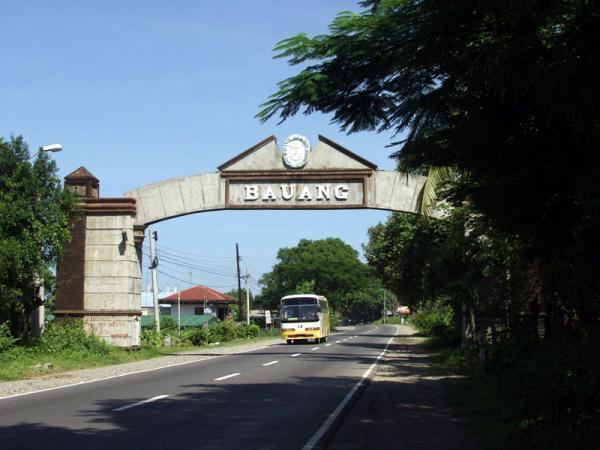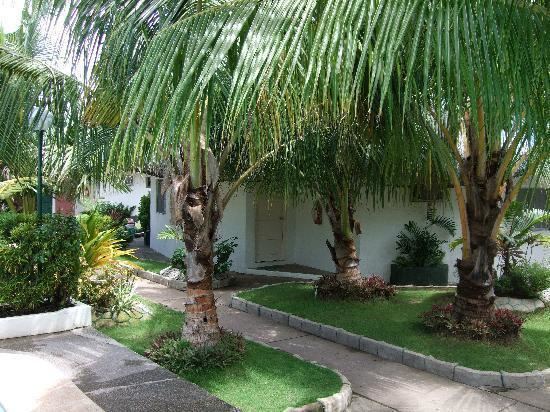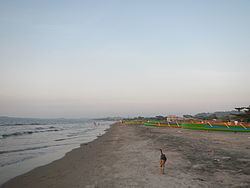Country Philippines Region Ilocos Founded January 5, 1586 | Area 73.15 km2 District 2nd District | |
 | ||
Mayor Eulogio Clarence Martin P. de Guzman III | ||
Map of Bauang
Bauang, officially the Municipality of Bauang, is a 1st class municipality in the province of La Union, Philippines. According to the 2015 census, it has a population of 75,032 people.
Contents
- Map of Bauang
- Ibp kamagong 1st place bauang la union oct 31 2012 clear copy
- Food market in bauang philippines in province of la union near san fernando
- History
- Etymology
- Demographics
- Local government
- Elected municipal officials 2013 2016
- Festivals and local events
- Beaches and sunsets of Bauang
- Sts Peter and Paul Parish Church
- 400 year old San Pedro Bell
- Education
- Industries infrastructure facilities and utilities
- Notable people from Bauang
- References

It is bordered by San Fernando City to the north, Caba to the south, Naguilian to the east, and the West Philippine Sea to the west.

The MacArthur Highway runs through the town, which junctions with Naguilian Road, one of the mountain roads leading to Baguio City.

Ibp kamagong 1st place bauang la union oct 31 2012 clear copy
Food market in bauang philippines in province of la union near san fernando
History
In 1590, Bauang started as a settlement. Spanish Friar Agustin Mino was appointed its first minister. In 1765, it became a town and formed part of Pangasinan. Don Francisco delos Reyes sat as its first gobernadorcillo. With the creation of La Union in 1850, Bauang became one of its twelve towns.
Like other towns in the province, Bauang also had its share in the devastating invasions of Moro pirates ("tirong") made series of invasions in Bauang, hence, the rise of watchtowers ("baluarte", by the Gobernadorcillo Don Juan Mallare). In 1890, Bauang "revolucionarios" led by Remigio Patacsil and Mauro Ortiz ousted the Spanish colonizers ("cazadores" or Spanish soldiers) and the "revolucionarios" (Filipinos).
In 1913, however, Bauang barrios were given to San Fernando: Pagudpud, Pagdalagan, Sevilla, Bungro, Tanquigan and Sibuan-Otong. In the Japanese war, heroes of Baunag fought in its beaches, in Lingayen Gulf, Bataan and Corregidor (as USAFIP-NL). The Japanese executed Manuel Arguilla, poet and journalist, Major Alberto O. Fenit (USAFFE) and Bauang Mayor Ambrosio Rimando. A town plaza monument today honors these Bauang heroes.
Bauang is known as the Beach Capital of the Philippines (1970, the shorelines of Baccuit Sur to Pagdalagan Sur). Bauang has a treasure: Research Reef (a dive spot for local and foreign scuba divers).
Bauang regularly hosts the South China Sea Regatta (led by the Royal Hong Kong Yacht Club.)
Etymology
Bauang originated from baoang (meaning "garlic"). The word buang also means "river split into two" flowing into the sea (a delta divides the Bauang River in two).
Bauang has a treasure: Research Reef (a dive spot for local and foreign scuba divers).
Bauang regularly hosts the South China Sea Regatta (led by the Royal Hong Kong Yacht Club.)
Demographics
In the 2015 census, the population of Bauang was 75,032 people, with a density of 1,000 inhabitants per square kilometre or 2,600 inhabitants per square mile.
Local government
Just as the national government, the Bauang's municipal government is divided into three branches: executive, legislative and judiciary. The judicial branch is administered solely by the Supreme Court of the Philippines. The LGUs have control of the executive and legislative branch.
The executive branch is composed of the mayor and the barangay captain for the barangays. The legislative branch is composed of the Sangguniang Bayan (town assembly), Sangguniang Barangay (barangay council), and the Sangguniang Kabataan for the youth sector.
The seat of Government is vested upon the Mayor Eulogio Clarence Martin P. De Guzman who holds office at the Bauang Town hall. The Sanguniang Bayan is the center of legislation.
Elected municipal officials 2013-2016
Festivals and local events
The natives, who are predominantly Roman Catholic, speak Iloko, Filipino, and English. The primary industries are farming, fishing, power plant and quarrying.
Bauang's main products are rice, corn, guapples and native grapes (barangays Payocpoc, Santiago, Bagbag and Urayong), mango, lowland vegetables, livestock, tobacco, marine products, saltwater fish politically.
Guapple by-products are also sold in Bauang: bread, buchi, chunky, cocktail, cookies, cupcake, dried, empanada, espasol, flan, guinataan, gulaman, inipit, jam, jelly, juice, kutsinta, pastilles, maja, marmalade, oatmeal, pie, yema, polvoron, preserved, rolls, siopao, tarts, turrones, macaroons, bars, and fingers as pasalubongs.
Beaches and sunsets of Bauang
Bauang is known for its fine-sand beaches, including Taberna, Baccuit Sur and Norte, Paringao, and Pagdalagan Sur beaches.
Bauang's beaches are accessible from several resorts: Bali Hai Beach Resort (Paringao), Long Beach Resort, Coconut Grove Beach Resort and San Luis del Mar (Baccuit Norte), inter alia.
Sts. Peter and Paul Parish Church
The Sts. Peter & Paul Parish Church (canonically erected on 25 April 1587 by the Augustinian missionaries) celebrates its fiesta every June 29. It is under the jurisdiction of the Roman Catholic Diocese of San Fernando de La Union (Dioecesis Ferdinandopolitana ab Unione, Suffragan of Lingayen – Dagupan, which was created on January 19, 1970 and erected on April 11, 1970, comprising the Civil Province of La Union, under the Titular, St. William the Hermit, February 10). It has been headed by the Most Rev. Rodolfo F. Beltran, D.D., bishop since 18 January 2013. The Church is under a diocese of the Latin Rite of the Roman Catholic Church in the Philippines from the Archdiocese of Nueva Segovia. The Church is also under the pastorship of Rev. Fr. Perpetuo Concepcion. Its Parochial Fiesta is on April 26.
The Saints Peter and Paul Church is one of the oldest church in the Philippines. Damaged by the 1892 earthquake, the Church was restored in 1895. Damaged again in 1944, the stone convent was destroyed in 1955. The Sacred Heart School now stands from the old Convent.
The Church has a rectangular four-storey bell tower (with two bells, restored with cement and hollow blocks in 1973). The Church interior was painted in 1978. The 16 July 1990 quake destroyed the facade which was later rebuilt. In 1901 US Army’s (then) Lt. Col. Thomas Barry, who was chasing Emilio Aguinaldo during the Philippine-American War, took the bell as a "token souvenir" and later gave the bell to his alma mater, the United States Military Academy at West Point, New York, where it was housed for over a century. The bell was ceremoniously returned to the Philippines in May 2016 to be reinstalled in the Peter and Paul Church.
The Grotto of our Lady of Lourdes is at the foot of the Church.
400-year old San Pedro Bell
On May 23, 2016, the 400-year old "San Pedro" bell made from alloy of gold, silver and copper has been returned to the Saints Peter and Paul Parish Church, after American soldiers during the Philippine-American War in 1901 took it from the church to West Point Academy in New York.
Education
Elementary schools:
Secondary schools:
Tertiary:
Industries, infrastructure facilities and utilities
1590 Energy Corporation The Bauang Diesel Power Plant formerly owned by the Bauang Private Power Corporation (BPPC) is a diesel-fired power plant which commenced operations in July 1995 with a 215 MW-capacity. State-owned National Power Corporation and the First Private Power Corp. (FPPC) entered into a Build-Operate-Transfer Agreement for the BPCC for a period of 15 years.
On July 26, 2010, after the BOT expiration, it was turned-over to the NAPOCOR and the Power Sector Assets and Liabilities Management Corp. (PSALM) and later to the Provincial Government of La Union. BothViviant Energy Corporation and Gigawatt Power, Inc. under the 1590 Energy Corp. operates the Bauang power facility provide the additional supply to the Luzon grid.
Major facilities inside the plant include a substation, two 100,000 bbl steel fuel storage tanks, sludge treatment plant, and five auxiliary buildings consisting of an administration building (812 sq.m), maintenance building (981 sq.m), warehouse building (591 sq.m), guest house (583 sq.m), bunk house (660 sq.m), and a canteen (550 sq.m).
The world’s largest medium speed power station in Bauang maintains an IMS certification for ISO 9901:2000, ISO 14001:2004, and OHSAS 18001 from Certification International.
PLDT Asia-Pacific Cable Network (APCN) in Baccuit Sur A Digital Optical Cable System for telecommunications services linking Hong Kong, Indonesia, Japan, Korea, Malaysia, Taiwan, Thailand, Singapore, and the Philippines is strategically located at the coastline barangay of Baccuit Norte in Bauang, La Union.
The facility, owned by the Philippine Long Distance Telecommunications Company, aims to benefit the users of telecommunications services and consequently stimulate the rapid expansion of business and government intercourse between the Philippines and the foreign countries to be served.
